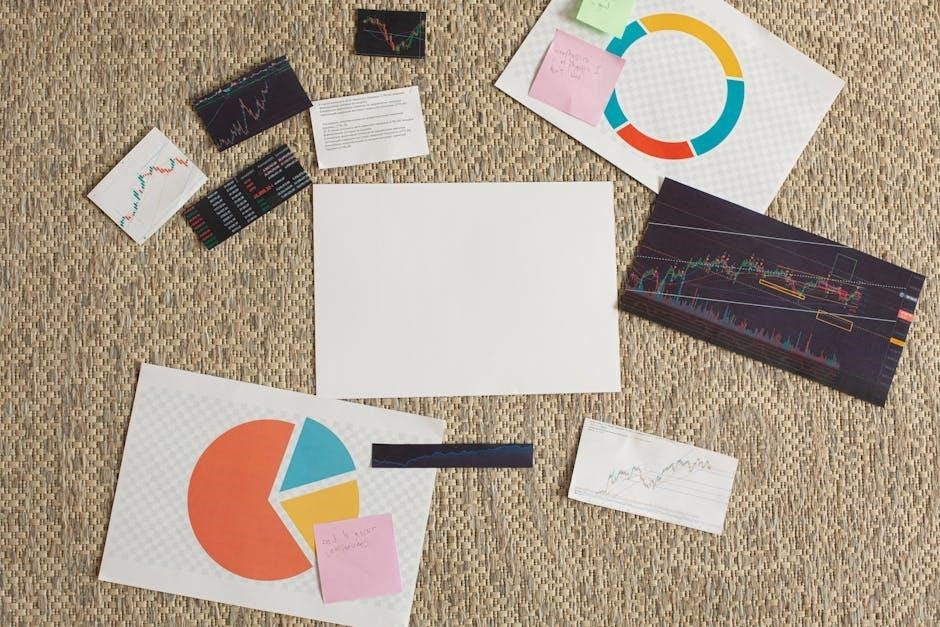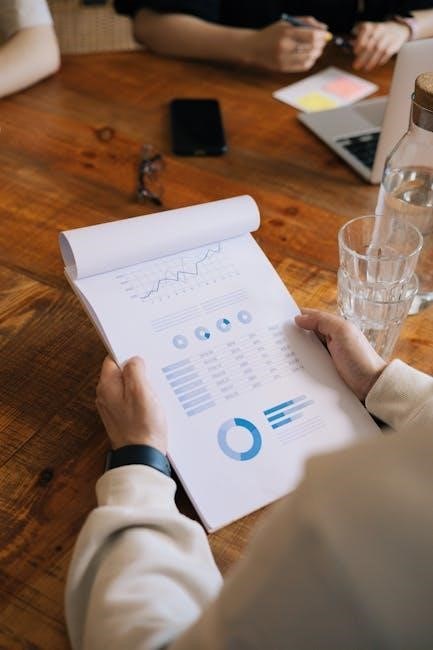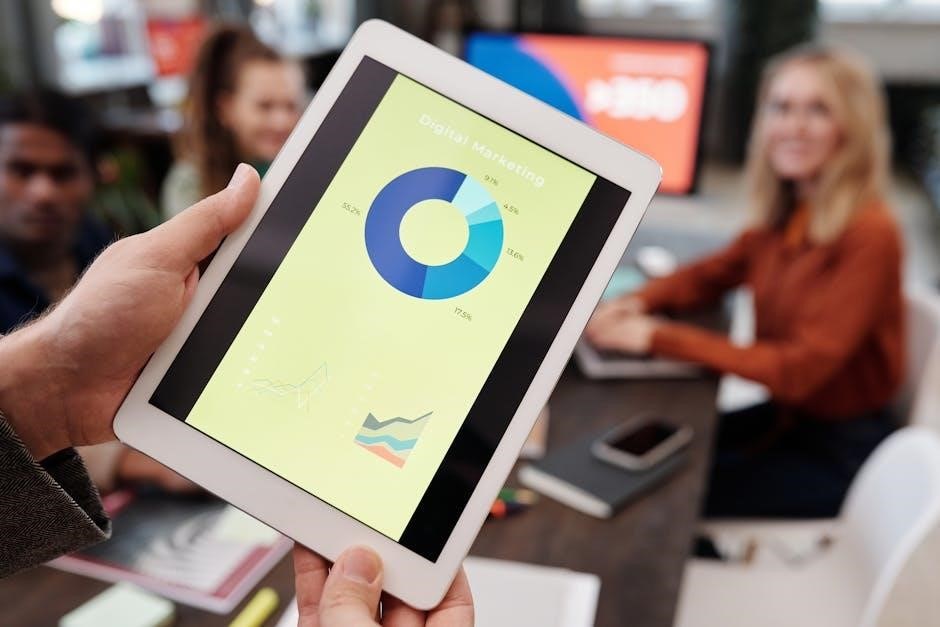Statistics project examples in PDF format provide practical insights into analyzing data, creating visualizations, and drawing meaningful conclusions․ They often include real-world applications in education, healthcare, and finance, demonstrating how statistical methods can solve complex problems․ These examples are invaluable for learners seeking to understand data interpretation and decision-making processes․
Overview of Statistics Projects
Statistics projects involve the collection, analysis, and interpretation of data to address specific questions or hypotheses․ These projects often apply descriptive and inferential statistical methods to real-world scenarios, providing insights into patterns, trends, and correlations․ Examples include analyzing student performance in education, patient outcomes in healthcare, or market trends in business․ By using tools like Excel, R, or Python, statisticians can visualize data, conduct hypothesis tests, and draw meaningful conclusions․ Such projects are essential for making data-driven decisions and solving complex problems across various industries․
Importance of Using PDF Examples
PDF examples of statistics projects serve as valuable learning tools, offering structured guidance and practical insights․ They provide clear illustrations of how to apply statistical methods to real-world data, making complex concepts more accessible․ These examples often include step-by-step analyses, visualizations, and interpretations, helping learners understand how to formulate hypotheses, conduct tests, and draw conclusions․ PDFs are also easily shareable and accessible, making them ideal for educational purposes․ They enable users to study successful projects and adapt techniques for their own research, fostering a deeper understanding of statistical principles and their applications․

Common Types of Statistics Projects
Statistics projects typically fall into categories like descriptive or inferential, focusing on data analysis, visualization, and interpretation․ These types help identify patterns, test hypotheses, and inform decision-making processes․
Descriptive Statistics Projects
Descriptive statistics projects focus on summarizing and presenting data to understand basic features․ They often involve calculating measures of central tendency (mean, median) and variability (range, standard deviation)․ These projects use tools like Excel, R, or Python to create visualizations such as bar charts, histograms, and box plots․ Examples include analyzing student performance, healthcare outcomes, or business sales data․ The goal is to provide clear, concise insights into data distributions and trends, making complex information accessible for decision-making․
Inferential Statistics Projects
Inferential statistics projects involve drawing conclusions about a population based on sample data․ Techniques like hypothesis testing, confidence intervals, and regression analysis are commonly used․ These projects often explore relationships between variables or predict future trends․ Examples include analyzing customer behavior, medical treatment efficacy, or economic factors․ Tools like R, Python, or Excel are frequently utilized to perform complex calculations and model data․ Inferential statistics projects are essential for making informed decisions by generalizing findings from a sample to a larger population, ensuring actionable insights․

Sample Statistics Project Ideas
Explore diverse project ideas across education, healthcare, and business sectors․ Analyze data to identify trends, predict outcomes, or compare groups using regression, hypothesis testing, or correlation methods effectively․
Education Sector Statistics Projects
Statistics projects in education often analyze student performance, teacher effectiveness, and socioeconomic impacts on learning․ Examples include studying grade trends over time, comparing test scores across regions, or assessing the influence of extracurricular activities on academic success․ These projects may use regression analysis to predict student outcomes or hypothesis testing to evaluate program effectiveness․ By leveraging data from schools, surveys, or standardized tests, educators can identify patterns and make data-driven decisions to improve educational strategies and resource allocation, ultimately enhancing student success and institutional performance․
Healthcare and Medical Statistics Projects
Healthcare statistics projects often focus on patient outcomes, disease trends, and treatment efficacy․ Examples include analyzing mortality rates, comparing drug effectiveness, or predicting readmission probabilities using predictive analytics․ Researchers might use regression analysis to identify risk factors for chronic diseases or hypothesis testing to evaluate vaccine efficacy․ Survival analysis is common in oncology studies to assess treatment impacts․ These projects rely on data from clinical trials, patient records, or public health databases, enabling healthcare professionals to make informed decisions and improve care quality while optimizing resource allocation and patient outcomes effectively․
Business and Finance Statistics Projects
Business and finance statistics projects involve analyzing financial data to uncover trends and patterns․ Common examples include studying stock price fluctuations, forecasting revenue, and assessing market risks․ Projects may use regression analysis to predict consumer spending or hypothesis testing to evaluate investment strategies․ Data visualization tools like Excel or Python are often employed to present insights clearly․ These projects help organizations optimize operations, make informed decisions, and improve profitability․ By leveraging statistical methods, businesses can gain a competitive edge and drive sustainable growth in dynamic markets․
Environmental Science Statistics Projects
Environmental science statistics projects focus on analyzing data related to climate change, air quality, and wildlife populations; Examples include studying temperature trends over decades or assessing the impact of pollution on ecosystems․ Projects often use regression analysis to predict future environmental changes․ Data is typically collected from field measurements, satellite imagery, or government databases․ Statistical tools like R or Python are employed for analysis․ Visualizations, such as heat maps or line graphs, help communicate findings․ These projects aim to inform policy decisions, promote sustainability, and address critical environmental challenges effectively․

Data Collection and Analysis Methods
Data collection involves gathering primary data through surveys, experiments, or observations and secondary data from existing sources․ Analysis methods include statistical techniques like regression, hypothesis testing, and visualization․
Primary Data Collection Techniques
Primary data collection involves gathering original data directly from sources․ Common techniques include surveys, interviews, experiments, and observations․ Surveys are widely used for collecting self-reported information, while interviews provide in-depth insights․ Experiments allow for controlled testing of variables, and observations enable researchers to collect data in natural or controlled settings․ These methods ensure data accuracy and relevance, making them essential for various statistics projects․ Proper execution of these techniques is crucial for reliable results․
Secondary Data Sources and Tools
Secondary data sources include pre-existing information from government reports, academic journals, industry studies, and online databases․ Tools like Google Scholar, JSTOR, and government websites provide access to extensive datasets․ These sources are cost-effective and time-saving, as the data is already collected․ However, verifying the credibility and relevance of secondary data is crucial for accurate analysis․ Common tools for accessing secondary data include statistical software like Excel, R, and Python libraries, which facilitate efficient data manipulation and analysis for statistics projects․
Statistical Tools and Software
Popular tools for statistical analysis include Excel, R, Python, and SPSS․ These software options enable data visualization, modeling, and hypothesis testing, essential for comprehensive statistics projects․
Using Excel for Statistical Analysis
Excel is a versatile tool for statistical analysis, offering functions like AVERAGE, STDEV, and CORREL․ Its data visualization features, such as charts and pivot tables, simplify complex data interpretation․ Add-ins like Analysis ToolPak enhance capabilities for regression and hypothesis testing․ Many statistics project examples in PDFs demonstrate Excel’s accessibility for descriptive and inferential analytics․ Templates and tutorials are widely available, making it a popular choice for students and professionals alike to perform robust statistical analyses efficiently․
R Programming for Advanced Statistics
R programming is a powerful tool for advanced statistical analysis, offering extensive libraries like dplyr and tidyr for data manipulation․ Functions such as lm enable linear regression, while caret and dplyr support machine learning tasks․ R’s flexibility in data visualization through ggplot2 makes it ideal for creating informative graphs․ These features, along with its open-source nature, make R a preferred choice for data scientists and researchers, facilitating complex tasks like hypothesis testing and predictive modeling with precision and efficiency․

Data Visualization in Statistics Projects
Data visualization transforms complex data into clear, interpretable insights, using charts, graphs, and plots․ Tools like Tableau and Power BI enhance understanding, making patterns and trends evident in statistics projects․
Best Practices for Creating Charts and Graphs
When crafting charts and graphs, clarity and accuracy are paramount․ Ensure labels are concise, axes are properly scaled, and colors are used judiciously to avoid confusion․ Avoid 3D effects that can distort data perception․ Use consistent formatting across visuals to maintain coherence․ Interactive tools like Tableau or Power BI allow dynamic data exploration, enhancing understanding․ Always align the visualization type with the data story being told, whether it’s trends, comparisons, or distributions․ Properly citing data sources adds credibility to your work․ Regularly review and refine your visuals for optimal impact․
Using Tools Like Tableau or Power BI
Tools like Tableau and Power BI are essential for creating dynamic and interactive visualizations in statistics projects․ They enable users to connect to various data sources, build dashboards, and explore data in real-time․ These platforms offer intuitive drag-and-drop interfaces, making it easier to create complex visualizations without extensive coding knowledge․ Features like data storytelling and collaboration tools enhance the sharing of insights․ By leveraging these tools, statisticians can transform raw data into actionable information, fostering better decision-making and clearer communication of results in PDF project examples․
CRISP-DM Methodology for Statistics Projects
CRISP-DM offers a structured framework for statistics projects, ensuring alignment with business objectives through systematic data analysis and modeling, fostering reliable outcomes and actionable insights․
Business Understanding Phase
The business understanding phase involves defining project objectives and identifying key stakeholders․ It requires understanding the organization’s goals, challenges, and expectations to align statistical analysis with business needs․ This phase ensures that the project addresses relevant problems and delivers actionable insights․ By engaging stakeholders and establishing clear objectives, the foundation for successful data analysis is laid, guiding subsequent phases effectively․
Data Understanding and Preparation
Data understanding and preparation involve exploring datasets to identify patterns, anomalies, and relationships․ This phase ensures data quality by cleaning, transforming, and formatting it for analysis․ Key activities include handling missing values, removing duplicates, and converting data types․ Proper preparation is crucial for accurate statistical modeling and meaningful insights․ Tools like Excel or Python are often used to streamline these processes, making data ready for advanced analysis in statistics projects․

Machine Learning Integration in Statistics
Machine learning enhances statistical analysis by automating pattern recognition and predictive modeling․ Techniques like regression and clustering integrate seamlessly, offering deeper insights into complex datasets and real-world applications․
Supervised Learning Applications
Supervised learning is widely applied in statistics projects for predicting outcomes based on labeled data․ Common examples include regression models for forecasting sales or classification tasks like customer churn prediction; These methods leverage historical data to train algorithms, enabling accurate predictions․ In healthcare, supervised learning aids in disease diagnosis, while in finance, it helps detect fraudulent transactions․ By utilizing labeled datasets, supervised learning enhances predictive accuracy, making it a cornerstone of modern statistical analysis and decision-making processes across various industries․
Unsupervised Learning Techniques
Unsupervised learning techniques are used to identify patterns or intrinsic structures in unlabeled data․ Common applications include clustering (e․g․, k-means) for customer segmentation and dimensionality reduction (e․g․, PCA) for simplifying complex datasets․ These methods are invaluable in exploratory data analysis, helping uncover hidden relationships without prior assumptions․ For instance, in market analysis, unsupervised learning can group similar consumer behaviors, aiding in targeted marketing strategies․ These techniques are essential for uncovering insights in datasets where predefined labels are unavailable, making them a powerful tool in statistical projects․

Real-World Applications of Statistics
Real-world applications of statistics include predictive analytics in retail and quality control in manufacturing, enabling data-driven decision-making and problem-solving across industries․
Predictive Analytics in Retail
Predictive analytics in retail leverages statistical models to forecast consumer behavior, optimizing inventory management and personalized marketing strategies․ By analyzing historical sales data and customer preferences, retailers can anticipate demand, reduce overstocking, and enhance profitability․ Advanced techniques like regression analysis and machine learning algorithms enable businesses to identify trends and deliver tailored recommendations, improving customer satisfaction and loyalty․ These insights empower retailers to make data-driven decisions, ensuring efficient operations and a competitive edge in the market․
Quality Control in Manufacturing
Statistical methods play a crucial role in quality control, ensuring manufactured products meet standards and customer expectations․ Techniques like control charts and Six Sigma help detect defects and process variations․ By analyzing data, manufacturers can identify trends, implement corrective actions, and improve production consistency․ These tools reduce waste, enhance reliability, and optimize efficiency․ Quality control statistics are essential for maintaining high product standards and fostering customer satisfaction, making them a cornerstone of modern manufacturing processes and continuous improvement initiatives․

Advanced Topics in Statistics
Advanced statistical topics like time series analysis and survival analysis explore complex data patterns and trends, enabling deeper insights into dynamic systems and event occurrences․
Time Series Analysis
Time series analysis involves studying data points collected over time to identify patterns, trends, and anomalies․ It is widely used in finance, climate science, and economics to forecast future events․ Techniques like ARIMA and SARIMA models help predict trends by analyzing historical data․ Seasonal decomposition and anomaly detection are key components․ Tools like Python and R are commonly used for such analyses․ Understanding temporal relationships enables better decision-making and resource planning․ This method is essential for industries relying on temporal data to optimize operations and strategic planning․
Survival Analysis
Survival analysis examines the duration until an event occurs, such as patient survival or product failure․ It helps identify risk factors and predict outcomes․ Techniques like Kaplan-Meier estimators and Cox proportional hazards models are used to analyze time-to-event data․ Widely applied in healthcare and engineering to understand failure rates and improve reliability․ Tools like R and Python provide robust libraries for implementation, making it essential for real-world applications and informed decision-making․

Best Practices for Statistics Projects
Ensure high-quality data, document processes, and report results clearly․ Use appropriate tools and maintain ethical standards to guarantee accuracy and reproducibility in your statistical work․
Ensuring Data Quality
Ensuring data quality is critical for reliable statistical outcomes․ This involves checking for accuracy, completeness, and consistency․ Use validation techniques to detect errors and handle missing data appropriately․ Regularly clean and preprocess data to maintain integrity․ Document all steps to ensure transparency and reproducibility․ Avoid bias by using representative samples and robust methodologies․ By prioritizing data quality, you enhance the credibility and validity of your statistical analysis, leading to more accurate and actionable insights in your projects․
Documenting and Reporting Results
Documenting and reporting results is essential for communicating findings effectively․ Use clear and concise language, supported by visual aids like charts and graphs․ Organize your report with sections such as introduction, methodology, analysis, and conclusions․ Ensure proper formatting, including tables, lists, and references․ Include an executive summary for quick insights and detailed appendices for raw data․ Maintain transparency by disclosing limitations and assumptions․ Tailor your report to the audience, ensuring technical accuracy for experts and accessibility for non-experts․ This approach enhances credibility and ensures reproducibility of your work․

Resources for Statistics Projects
Explore recommended PDF guides, online communities, and educational platforms for statistics projects․ Utilize tools like Excel, Python, and R for data analysis․ Visit forums and academic sites for insights and templates to enhance your project workflow and accuracy․
Recommended PDF Guides and Templates
Statistics project examples in PDF format offer comprehensive guides and templates to streamline your workflow․ These resources provide step-by-step instructions, sample datasets, and pre-designed templates for data visualization and analysis․ Many guides focus on methodologies like CRISP-DM, ensuring a structured approach to project planning and execution․ Templates for reports, charts, and graphs help present findings professionally․ Additionally, PDF guides often include tips for using tools like Excel, R, and Python, making them invaluable for both beginners and advanced statisticians․ They are easily accessible online and cover a wide range of project types․
Online Communities and Forums
Online communities and forums are excellent resources for statistics project examples and guidance․ Platforms like Kaggle, Stack Overflow, and Reddit host discussions on data analysis, offering insights and shared experiences․ Many forums provide access to downloadable PDF guides, templates, and sample projects․ These spaces foster collaboration, allowing users to ask questions, share challenges, and receive expert advice․ They also serve as hubs for discovering new tools, methodologies, and best practices in statistical analysis․ Engaging with these communities can significantly enhance your project outcomes and learning journey․
